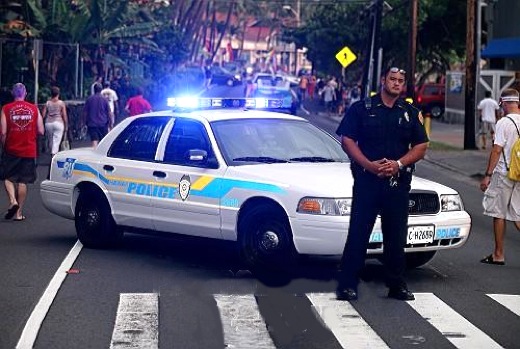 Image above: Police roadblock in Kailua-Kona, Hawaii. From (http://www.photographersdirect.com/buyers/stockphoto.asp?imageid=2308292).
Image above: Police roadblock in Kailua-Kona, Hawaii. From (http://www.photographersdirect.com/buyers/stockphoto.asp?imageid=2308292).
A few years ago HECO released a Request for Proposal which asked for 100 MW of renewable energy for O`ahu. Castle & Cooke proposed 400 MW from Lana`i and First Wind proposed 400 MW from Moloka`i. A settlement was reached where 200 MW would come from each island.
Programmatic Environmental Impact Statement
Using federal Stimulus Funds, AECOM was hired by DBEDT to write the Programmatic Environmental Impact Statement (PEIS) for Big Wind.
The PEIS Preparation Notice was released in December 2010. The PEIS Scoping document looked at only two options: Big Wind with planning and Big Wind without planning.
Public comments poured in during the December 2010 to March 2011 comment period. Federal, state and county agencies and federal , state and local non-profit organizations pointed out the an EIS is required to take a “hard look” at a full range of alternatives.
State Procurement Office
DBEDT felt that they needed more money to complete the EIS process, so they asked the State Procurement Office to exempt the additional studies from a competitive bid solicitation. DBEDT reasoned that since AECOM already had a foot in the door, and thus would have a leg up on any potential rival, AECOM should be given more funds outside of the procurement code.
DBEDT is “requesting broadening the scope of services with no additional costs to state, but funding for original contract and inclusion of the broader scope comes from ARRA funds that needed to be expended by 04/30/12.”
As DBEDT continued to examine the public comments they came to realize that more alternatives needed to be examined within the EIS process, so they added industrial scale solar and geothermal alternatives on Maui but opted not to examine centralized and dispersed solar options on O`ahu and geothermal from the Big Island.
On September 29, 2011 DBEDT filed Amendment 1 with the State Procurement Office “ requesting the additional scope of services (solar/photovoltaic and geothermal) at an additional cost of $2.1 mil [million].”
The Amendment stated in part: “after DBEDT compiled and sorted through comments from more than 250 individuals and entities, it became apparent that the request from the public for DBEDT to study additional renewable energy technologies as part of the programmatic EIS was an overwhelmingly common theme.”
On October 27, 2011, the State Procurement Office rejected the exemption. “It seems very short sighted and detached from the subject matter on DBEDT’s part that the public had to inform them they should consider solar/photovoltaic and geothermal technologies. DBEDT knew of these technologies at the time they issued the initial solicitation and had the opportunity to include it in the solicitation for proper disclosure and open competition. DBEDT chose the narrow scope of services.”
Public Utilities Commission
First Wind’s Moloka`i proposal collapsed since they could not secure a site.
Recently the PUC opened a docket so that HECO could ask for competitive bids to make up for that 200 MW. The PUC said that any renewable from any island that could connect to O`ahu would be considered.
Hawaiian Electric Company file a Draft Request for Proposal for 200 MW of renewable energy with the PUC. HECO insisted that anyone who proposes a solution using Neighbor Island resources has to have a way of delivering the power to O`ahu, and that anyone who proposes to build a cable to O`ahu from anywhere has to include a cable from Lana`i to O`ahu.
Castle & Cooke is in negotiations with Moloka`i Ranch and Pattern Energy for a 200 MW windfarm on Moloka`i and to increase Lana`i’s proposed wind farm from 200 MW to 400 MW.
Thus any other Neighbor Island proposal would be dead on arrival, since proposing a cable to Lana`i requires getting David Murdoch’s approval to land a cable on Lana`i and interconnect it to the Lana`i wind farm. Castle & Cooke has veto power over all other Neighbor Island submittals and therefore the DBEDT proposal to look at other Maui alternatives is a sham.
Proposed Regulatory Interventions
Four groups have requested to the PUC that they be admitted as parties in the RFP regulatory proceedings: (1) Friends of Lana`i, represented by Attorney Isaac Hall; (2) I Aloha Molokai; (3) Lana`i and Moloka`i Hawaiians (Kaulana Kaho'ohalahala, Clarence Halona Kaopuiki, and Matthew Mano) represented by the Native Hawaiian Legal Corp. (NHLC); and (4) Life of the Land.
The Consumer Advocate took no position on the proposed interventions, while HECO always opposes anyone who seeks to become a party in any utility action.
Friends of Lana`i attorney Isaac Hall noted that the greatest length of the “required” Lana`i-O`ahu cable is in waters beyond three miles from the shore, in an area that the PUC does not have jurisdiction over. In addition, the PUC does not have the legal authorization to require competitively bidding for transmission lines or fuel, only power generators.
HECO’s Request for Ratepayer Funds to Pay for Big Wind Studies
In other action before the PUC, HECO is stonewalling on the release of documents to Life of the Land via discovery. In essence, HECO wants ratepayer funds to cover studies without submitting any proof that the studies were done in the public interest.
Association of Hawaiian Civic Clubs
On October 29, 2011, at the Annual Convention of the Association of Hawaiian Civic Clubs at Turtle Bay, Resolution 11-50 was passed: “Urging Governor Neil Abercrombie and the Hawai`i State Legislature to Support Sustainable, Low Impact Alternative Energy that will make O`ahu Energy Self Sufficient Rather than Dependent upon Lana`i and Moloka`i for its Energy and Protect the Open Spaces, Natural Resources and the Hawaiian Lifestyle of Moloka`i, the last Hawaiian Island.”
No comments :
Post a Comment